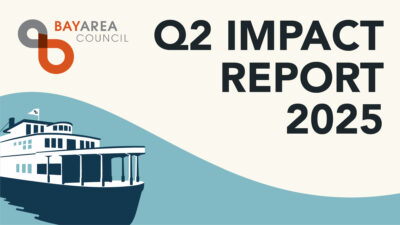New Analysis Shows Number of Jobs that Can Work from Home in the Bay Area, Highlights Regional Implications
SAN FRANCISCO—The Bay Area has a higher percentage of jobs eligible for remote work than any other major metropolitan region in the state, according to a new Bay Area Council Economic Institute study that examines how the move away from commercial office centers could put at risk hundreds of thousands of service and support jobs, dramatically alter commute and transit patterns and disproportionately affect minority and lower-income communities.
The 45% of employees across the nine-county Bay Area whose jobs make them eligible to work remotely exceeds that of Los Angeles (38%), San Diego (39%), Orange County (39%) and Sacramento (40%), with three Bay Area Counties—San Francisco (51%), Santa Clara (51%) and San Mateo (47%) counties—leading the way.
How many of those jobs remain remote permanently could determine the fate of hundreds of thousands of other jobs—everything from restaurant and other food service jobs to maintenance, security, construction and transportation jobs—that have relied on dense commercial centers for their existence. An examination of just 12 cities across the Bay Area found a permanent shift to remote working could impact 265,000 other jobs. Additionally, the data highlight the potential for remote work to drive down daytime populations in downtown areas like San Francisco’s financial and SOMA districts, where 67% and 61%, respectively, of total jobs are remote work eligible.
“Remote work has been critical to sustaining our regional economy through the COVID-19 pandemic,” said Jeff Bellisario, Executive Director of the Bay Area Council Economic Institute. “But remote work also could bring significant structural changes to the economy and the way the region plans for the future. This report provides important data on the region’s occupations, which shows that remote work will have different positive effects and unintended consequences across the nine counties.”
The study outlines a number of areas that should be considered if remote work becomes more prevalent over the next few decades—either via employee and business preference or by public policy—including the future of downtown commercial districts, shifts in housing preferences, greenhouse gas emission effects, transit revenue impacts, equity in remote work opportunities and service sector disruptions.
For example, income and racial disparities show that large portions of the population are unable to enjoy benefits of working remotely. Among those employed in the Bay Area in occupations with an average annual income below $40,000, only 6% are eligible to work from home. On the other end of the spectrum, among those employed in an occupation that has an average annual income over $150,000, 76% are eligible for remote work. Across the nine counties, 51% of the white workforce held jobs that were eligible to work remotely, while only 33% of the Black workforce and 30% of the Latinx workforce were employed in occupations that are able to work remotely.
“The study highlights both the potential upside and downside of remote work for businesses and workers alike” said Santa Clara County Supervisor Cindy Chavez, Chair of the BARC Governing Board. “It makes clear that there is no one-size-fits-all solution for managing the range of possible outcomes. As we emerge out of the pandemic and consider lasting structural changes, we need to be flexible and adaptive, and make sure we’re asking the right questions.”
The analysis seeks to gather initial data and research to help lay a foundational understanding of the opportunities and challenges around remote work in the nine-county region that will inform planners and policymakers as they look for ways to capture the potential environmental benefits of remote work while limiting its unintended economic consequences. The Council and BARC note that further data collection, including surveys of employers and employees as well as research in remote work preferences, is necessary to supply more nuance into the potential uptake and frequency of remote work.
Read the full study here>>





